Filter interviews by
Radnik Exports Cutting Manager Interview Questions and Answers
Radnik Exports Cutting Manager Interview Experiences
1 interview found
I applied via Approached by Company and was interviewed in Feb 2023. There were 2 interview rounds.

(5 Questions)
- Q1. 12345 question and cutting to
- Q2. 12345 cutting and quality and s
- Q3. 45678 compliance reletive to
- Q4. 12345 costing and manpower to
- Q5. 12345 costing and avg width to
Interview Preparation Tips
Top trending discussions






Interview questions from similar companies

I applied via Newspaper Ad and was interviewed before Sep 2021. There were 2 interview rounds.

(28 Questions)
- Q1. Type fabric and handling method
- Ans.
The type of fabric and handling method are important factors in cutting management.
Different fabrics require different cutting techniques
Handling methods can affect the quality and accuracy of the cut
Some fabrics may require special equipment or tools for cutting
Factors such as fabric thickness, stretch, and texture should be considered
Examples: cutting silk with a rotary cutter, using a hot knife for synthetic fabrics
- Q2. Fabric to finishing goods for ready to pack
- Q3. Any questions our responsibility
- Q4. Work my responsibilities
- Q5. Cpm control my responsibilities
- Q6. Yarn to fabric production
- Q7. Weaving ,loom section operations
- Q8. Weaving process completed
- Ans.
The weaving process has been completed.
The woven fabric is inspected for quality.
The fabric is then cut into desired shapes and sizes.
The cut pieces are then sent for stitching or other finishing processes.
- Q9. Singing process, desizeing process
- Q10. Ready to fabricx goods
- Ans.
Yes, I am ready to fabricate goods.
I have experience in fabricating goods.
I am familiar with the necessary equipment and tools.
I am able to read and interpret technical drawings and specifications.
I am able to work efficiently and meet deadlines.
I am committed to producing high-quality products.
- Q11. Fabric received to fabric store
- Ans.
Fabric received to fabric store is checked for quality and quantity before being stored.
The fabric is inspected for any defects or damages.
The quantity of the fabric is verified against the purchase order.
The fabric is labeled and stored in the appropriate location.
Any discrepancies are reported to the supplier for resolution.
Regular inventory checks are conducted to ensure accuracy.
- Q12. 4 point inspection ok or not ok
- Q13. Next fabric moving to cutting
- Ans.
The next fabric to be moved to cutting is the blue cotton fabric.
The fabric has been inspected and approved for cutting.
The cutting team has been notified of the fabric's arrival.
The fabric will be labeled and organized before cutting begins.
- Q14. Lot card report and fabric GSM reports
- Q15. Cutting moving fabric
- Ans.
Cutting moving fabric requires caution and precision.
Ensure the fabric is properly secured before cutting.
Use sharp scissors or a rotary cutter to make clean cuts.
Cut in a straight line and avoid jagged edges.
Be aware of the direction of the fabric's movement to avoid mistakes.
Take breaks to avoid fatigue and maintain focus.
- Q16. GSM verify and fabric shade confirm
- Q17. Cutting pattern verify
- Q18. Sample one pcs cutting product
- Ans.
A sample cutting product is a metal sheet cut into a circular shape.
The cutting product is made of metal.
It is cut into a circular shape.
The product has a smooth edge.
The thickness of the metal sheet is 2mm.
The diameter of the circular shape is 10cm.
- Q19. Product stitching issued
- Q20. Product and accessories same send it
- Q21. Product stitching in cutting panels
- Ans.
Product stitching in cutting panels is a crucial step in ensuring quality and accuracy in the final product.
Proper alignment of panels is necessary for accurate stitching
Cutting panels with precision reduces the need for excessive stitching
Using appropriate stitching techniques ensures durability and longevity of the product
- Q22. Ready to product stitching
- Q23. Goods moving in checking department
- Ans.
Goods moving in checking department refers to the process of inspecting and verifying the quality and quantity of goods before they are released for distribution.
Checking department ensures that the goods meet the required standards and specifications.
The process involves physical inspection, documentation review, and testing if necessary.
Goods that fail to meet the standards are rejected and sent back to the supplier ...
- Q24. Next finishing department through in ironing. Process
- Ans.
Ironing is the next process in the finishing department.
Garments are fed into the ironing machine.
The machine applies heat and pressure to remove wrinkles and creases.
Ironing is done according to the fabric type and garment style.
After ironing, garments are inspected for quality and packed for shipment.
- Q25. Check our ironing methods correctly throughout box moving
- Ans.
Ensure proper ironing methods are followed during box movement
Train employees on correct ironing techniques
Regularly inspect boxes to ensure proper ironing
Implement quality control measures to catch any mistakes
Use appropriate equipment and tools for ironing
Document any issues and provide feedback to employees
- Q26. Polycover goods ready
- Q27. Box through in box completed
- Q28. Box send the shipment
Interview Preparation Tips
- Fabric
- Quality
- Cutting
- Production
- Finishing
- Black Box

I applied via Newspaper Ad and was interviewed before Sep 2021. There were 2 interview rounds.

(28 Questions)
- Q1. Type fabric and handling method
- Ans.
The type of fabric and handling method are important factors in cutting management.
Different fabrics require different cutting techniques
Handling methods can affect the quality and accuracy of the cut
Some fabrics may require special equipment or tools for cutting
Factors such as fabric thickness, stretch, and texture should be considered
Examples: cutting silk with a rotary cutter, using a hot knife for synthetic fabrics
- Q2. Fabric to finishing goods for ready to pack
- Q3. Any questions our responsibility
- Q4. Work my responsibilities
- Q5. Cpm control my responsibilities
- Q6. Yarn to fabric production
- Q7. Weaving ,loom section operations
- Q8. Weaving process completed
- Ans.
The weaving process has been completed.
The woven fabric is inspected for quality.
The fabric is then cut into desired shapes and sizes.
The cut pieces are then sent for stitching or other finishing processes.
- Q9. Singing process, desizeing process
- Q10. Ready to fabricx goods
- Ans.
Yes, I am ready to fabricate goods.
I have experience in fabricating goods.
I am familiar with the necessary equipment and tools.
I am able to read and interpret technical drawings and specifications.
I am able to work efficiently and meet deadlines.
I am committed to producing high-quality products.
- Q11. Fabric received to fabric store
- Ans.
Fabric received to fabric store is checked for quality and quantity before being stored.
The fabric is inspected for any defects or damages.
The quantity of the fabric is verified against the purchase order.
The fabric is labeled and stored in the appropriate location.
Any discrepancies are reported to the supplier for resolution.
Regular inventory checks are conducted to ensure accuracy.
- Q12. 4 point inspection ok or not ok
- Q13. Next fabric moving to cutting
- Ans.
The next fabric to be moved to cutting is the blue cotton fabric.
The fabric has been inspected and approved for cutting.
The cutting team has been notified of the fabric's arrival.
The fabric will be labeled and organized before cutting begins.
- Q14. Lot card report and fabric GSM reports
- Q15. Cutting moving fabric
- Ans.
Cutting moving fabric requires caution and precision.
Ensure the fabric is properly secured before cutting.
Use sharp scissors or a rotary cutter to make clean cuts.
Cut in a straight line and avoid jagged edges.
Be aware of the direction of the fabric's movement to avoid mistakes.
Take breaks to avoid fatigue and maintain focus.
- Q16. GSM verify and fabric shade confirm
- Q17. Cutting pattern verify
- Q18. Sample one pcs cutting product
- Ans.
A sample cutting product is a metal sheet cut into a circular shape.
The cutting product is made of metal.
It is cut into a circular shape.
The product has a smooth edge.
The thickness of the metal sheet is 2mm.
The diameter of the circular shape is 10cm.
- Q19. Product stitching issued
- Q20. Product and accessories same send it
- Q21. Product stitching in cutting panels
- Ans.
Product stitching in cutting panels is a crucial step in ensuring quality and accuracy in the final product.
Proper alignment of panels is necessary for accurate stitching
Cutting panels with precision reduces the need for excessive stitching
Using appropriate stitching techniques ensures durability and longevity of the product
- Q22. Ready to product stitching
- Q23. Goods moving in checking department
- Ans.
Goods moving in checking department refers to the process of inspecting and verifying the quality and quantity of goods before they are released for distribution.
Checking department ensures that the goods meet the required standards and specifications.
The process involves physical inspection, documentation review, and testing if necessary.
Goods that fail to meet the standards are rejected and sent back to the supplier ...
- Q24. Next finishing department through in ironing. Process
- Ans.
Ironing is the next process in the finishing department.
Garments are fed into the ironing machine.
The machine applies heat and pressure to remove wrinkles and creases.
Ironing is done according to the fabric type and garment style.
After ironing, garments are inspected for quality and packed for shipment.
- Q25. Check our ironing methods correctly throughout box moving
- Ans.
Ensure proper ironing methods are followed during box movement
Train employees on correct ironing techniques
Regularly inspect boxes to ensure proper ironing
Implement quality control measures to catch any mistakes
Use appropriate equipment and tools for ironing
Document any issues and provide feedback to employees
- Q26. Polycover goods ready
- Q27. Box through in box completed
- Q28. Box send the shipment
Interview Preparation Tips
- Fabric
- Quality
- Cutting
- Production
- Finishing
- Black Box
Radnik Exports Interview FAQs
Tell us how to improve this page.
Radnik Exports Interviews By Designations
Interview Questions for Popular Designations
- Cutting Incharge Interview Questions
- Asic Design Verification Engineer Interview Questions
- Physical Education Teacher Interview Questions
- Account Assistant Interview Questions
- Male Staff Nurse Interview Questions
- Public Relation Officer Interview Questions
- Foreman Interview Questions
- International Business Development Manager Interview Questions
- Show more
Radnik Exports Cutting Manager Interview Process
based on 1 interview
Interview experience
Interview Questions from Similar Companies
Radnik Exports Cutting Manager Reviews and Ratings
based on 1 review
Rating in categories
|
Merchandiser
32
salaries
| ₹1.8 L/yr - ₹6.6 L/yr |
|
Senior Merchandiser
24
salaries
| ₹6.4 L/yr - ₹10 L/yr |
|
Assistant Merchandiser
24
salaries
| ₹2.2 L/yr - ₹4 L/yr |
|
PD Merchandiser
16
salaries
| ₹3 L/yr - ₹7.2 L/yr |
|
Assistant Manager
13
salaries
| ₹5 L/yr - ₹10 L/yr |

Global Connections
Vibrant Industries

Monte Carlo

YKK
- Home >
- Interviews >
- Radnik Exports Interview Questions >
- Radnik Exports Cutting Manager Interview Questions














